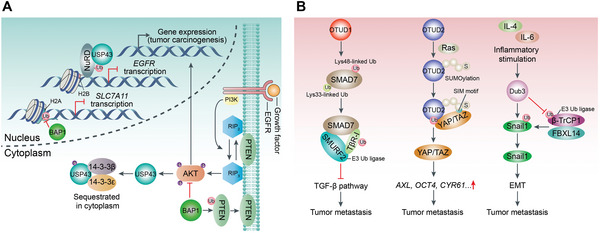Figure 7.

DUBs regulate tumor metastasis. A) USP43 interacts with NuRD to synergistically catalyze H2BK120 deubiquitination and repress EGFR expression which suppresses the activity of the EGFR/PI3K/AKT pathway, as well as the growth and metastasis of cancer. However, USP43 can be phosphorylated by activated AKT, and sequestrated in the cytoplasm to limit USP43 function. Additionally, BAP1 deubiquitinates and stabilizes PTEN (a protein that negatively governs the AKT pathway). Besides, BAP1 deubiquitinates H2A on the SLC7A11 promoter and represses SLC7A11 expression, which causes ferroptosis to control tumor development and metastasis. B) OTUD1 has dual effects on SMAD7 according to the Ub linkage type. OTUD1 selectively cleaves Lys48‐linked Ub chain from SMAD7 to prevent it from proteasomal degradation which promotes tumor metastasis. Moreover, OTUD1 eliminates Lys33‐linked Ub chain from SMAD7, which can be subsequently bound by SMURF2 (E3 Ub‐protein ligases) to degrade TβRI through ubiquitination, thereby inhibiting the TGF‐β pathway and tumor metastasis. SUMOylated OTUB2 interacts with YAP/TAZ by the SUMO‐interacting motif in YAP and TAZ which promotes the accumulation of YAP and TAZ through deubiquitination and the transcriptional activation of AXL, OCT4, CYR61 to increase cell proliferation and metastasis. Dub3 is induced by IL‐4 and IL‐6, and stabilizes Snail1 (a pivotal EMT‐driving transcription factor) through its deubiquitinase activity, and promotes tumor cell migration, invasion, and metastasis.
